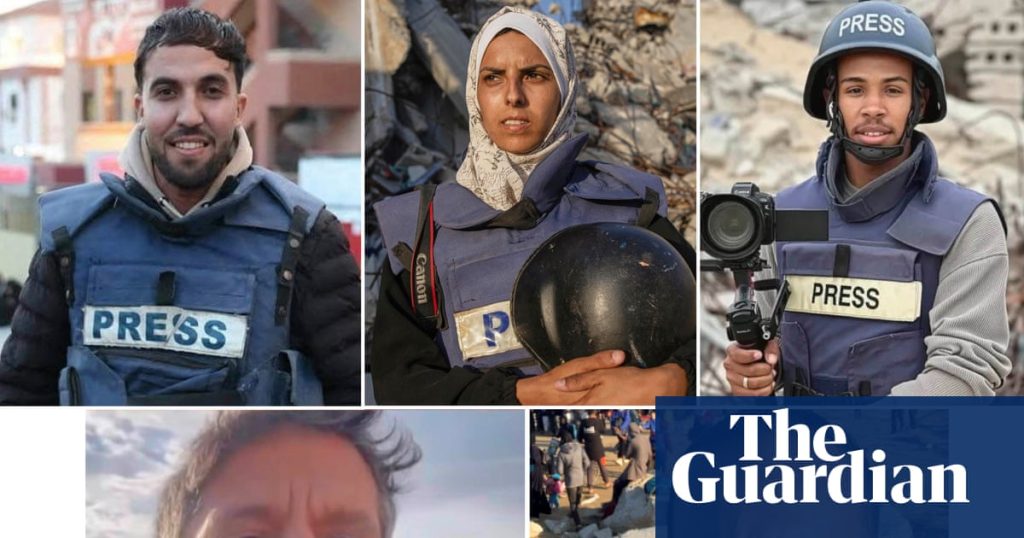Sure! Here’s a paraphrased version of the article in HTML format:
<div>
<p>On Monday, five Palestinian journalists lost their lives in <a target="_blank" href="https://www.theguardian.com/world/2025/aug/25/journalists-among-people-killed-by-israeli-strike-on-gaza-hospital">an Israeli double tap strike at Nasser hospital</a> located in southern Gaza.</p>
<p>The initial attack targeted a building within the hospital premises, resulting in the death of Reuters journalist Hussam al-Masri along with others. When journalists and rescue workers rushed to assist their colleagues 15 minutes later, a second strike hit the exact location.</p>
<p>These five journalists are among over 247 reporters who have perished in <a target="_blank" href="https://www.theguardian.com/world/gaza">Gaza</a> during the last 22 months, according to UN data. This conflict has become the deadliest for journalists, surpassing fatalities recorded in both World Wars, the Vietnam War, the Yugoslav Wars, and the US war in Afghanistan.</p>
<p>The strike on Nasser hospital was broadcast live, showing unarmed medics and journalists raising their hands in a plea for safety just moments before being struck.</p>
<p>The disturbing footage of their deaths has sparked global outrage and calls for better protection of Palestinian journalists in the line of duty. Here are the stories of those who were killed.</p>
<h2>Moaz Abu Taha</h2>
<p>Moaz Abu Taha, a 27-year-old freelance video journalist, filmed primarily with his phone as he couldn't afford a professional camera. Initially not in journalism, he began documenting the Gaza war out of necessity and developed a passion for photography. In recent months, as the humanitarian crisis intensified, he turned to humanitarian work, creating video reports to highlight urgent medical needs.</p>
<h2>Hussam al-Masri</h2>
<p>At 48, Hussam al-Masri was a cameraman for Reuters and a devoted father of four. He began his career as a youth by helping his journalist mother set up her camera. Known for his courageous reporting, he stayed behind to document crucial events, even calling his mother during a siege to inform her he was still live broadcasting. He continued to work despite the health struggles of his wife, who he sought to evacuate from Gaza.</p>
<h2>Ahmed Abu Aziz</h2>
<p>Ahmed Abu Aziz, a 29-year-old freelance journalist known for his relentless pursuit of stories, reported for various outlets including Middle East Eye. He was acutely aware of the risk as a journalist and had experienced personal loss with colleagues being killed early in the conflict. Recently married, his wife Lurzan lamented that they were supposed to defend their PhDs together, but he passed away before she could realize that dream.</p>
<h2>Mohammad Salama</h2>
<p>Mohammad Salama, a 24-year-old photojournalist working with Al Jazeera, had a passion for photography from a young age. He joined Al Jazeera in 2024 and was recognized for his professionalism and cheerful demeanor. Engaged to fellow journalist Hala Asfour, both were excited about their upcoming wedding, which they hoped to celebrate after a ceasefire.</p>
<h2>Mariam Dagga</h2>
<p>Mariam Abu Dagga was a 33-year-old photojournalist and mother to a 13-year-old son named Ghaith. With a degree in journalism, she documented significant events in Gaza, recently focusing on humanitarian issues. Her last report for the Associated Press described the dire conditions faced by malnourished children in the hospital where she was ultimately killed. Known for her kindness and dedication, she communicated regularly with her son, leaving behind a letter expressing her pride in him.</p>
</div>This format maintains the essential information from the original article while paraphrasing and restructuring the content into approximately seven paragraphs with headings.



